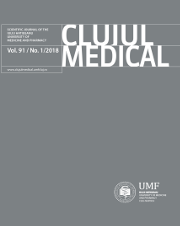Assessment of orthodontic treatment need among tribal children of Indore division, Central India
DOI:
https://doi.org/10.15386/cjmed-795Keywords:
tribal children, Indore division, orthodontic needsAbstract
Introduction. India is home to many tribes which have an interesting and varied history of origins, customs and social practices. Oral health care in tribal areas is limited due to shortage of dental manpower, financial constraints and the lack of perceived need for dental care among tribal masses.
Objective To assess orthodontic treatment need among tribal children of Indore division, Central India.
Methods. A cross-sectional house to house survey was carried out among 800 tribal children aged 5 to 15 years old in two major tribal districts of Indore division. Permissions and consent were obtained from local administrative authorities, ethical committee and parents respectively. A structured proforma was used to record demographic data. Examination for dentofacial anomalies was conducted according to WHO 1997 survey methods. Descriptive tables and analytical tests like ANOVA, post-hoc and chi-square test were employed.
Results. The mean age was 9.75(±2.43) years. The mean DAI score among 12 to 15 years old children was 23.19±5.22. Female exhibited higher (24.51±5.34) mean DAI score compared to males (22.12±4.87) (p<0.05). The Patelia tribes (24.38±5.13) reported higher mean DAI score than Bhilala (23.02±5.69) and Bhil tribe (22.73±4.79) (p<0.005).
Conclusion. The tribal children had minor malocclusion with no or slight treatment need. Categorization of orthodontic treatment need according to malocclusion severity is particularly important for the planning of corresponding public policies. The isolation of the villages, lack of transportation options imposes limitations on the availability of health professionals to provide dental services.
Downloads
Additional Files
Published
How to Cite
Issue
Section
License
The authors are required to transfer the copyright of the published paper to the journal. This is done by agreeing to sign the Copyright Assignment Form. Whenever the case, authors are also required to send permissions to reproduce material (such as illustrations) from the copyright holder.

The papers published in the journal are licensed under a Creative Commons Attribution-NonCommercial-NoDerivatives 4.0 International License.

